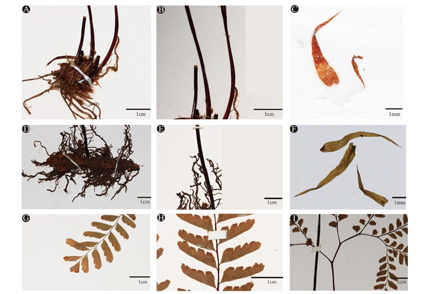Abstract
The Adiantum pedatum complex is disjunctly distributed in North America and eastern Asia. In this study, we carried out a detailed morphological study based on 137 specimens representing the biogeographic diversity of this complex. The sequences of eight chloroplast markers of 35 samples were analyzed with maximum likelihood and Bayesian inference. The morphological and phylogenetic analyses support the recognition of a new species of the A. pedatum complex from Japan. We propose the new species as A. japonicum based on the examinations of specimens from Japan and the comparative analyses of the whole complex. This new species can be distinguished from A. pedatum by the erect rhizome and shows significant molecular differences from other species in this complex. A taxonomic description with detailed morphological characters of the new species is presented.
References
Christ, H. (1902) Filices Bodinieriauae. Bulletin de l’Académie Internationale de Géographie Botanique, sér. 3, 11 (153–154): 189–276. [https://www.biodiversitylibrary.org/bibliography/3637]
Doyle, J.J. & Doyle, J.L. (1987) A rapid DNA isolation procedure for small quantities of fresh leaf tissue. Phytochemical Bulletin 9: 11–15. [https://worldveg.tind.io/record/33886/]
Galan, J.M.G.Y., Prada, C., Rolleri, C., Ainouche, A. & Vicent, M. (2013) CpDNA supports the identification of the major lineages of American Blechnum (Blechnaceae, Polypodiopsida) established by morphology. Turkish Journal of Botany 37: 769–777. https://doi.org/10.3906/bot-1210-49
Huiet, L., Li, F.W., Kao, T.T., Prado, J., Smith, A.R., Schuettpelz, E. & Pryer, K.M. (2018) A worldwide phylogeny of Adiantum (Pteridaceae) reveals remarkable convergent evolution in leaf blade architecture. Taxon 67: 488–502. https://doi.org/10.12705/673.3
Iwatsuki, K. (1995) Parkeriaceae. In: Iwatsuki, K., Yamazaki, T., Boufford, D.E. & Ohba, H. (eds.) Flora of Japan. Vol. 1. Pteridophyta and Gymnospermae. Kodansha, Tokyo, pp. 77–85.
Kearse, M., Moir, R., Wilson, A., Stones-Havas, S., Cheung, M., Sturrock, S.S., Buxton, S., Cooper, A., Markowitz, S., Duran, C., Thierer, T., Ashton, B., Meintjes, P. & Drummond, A. (2012) Geneious Basic: An integrated and extendable desktop software platform for the organization and analysis of sequence data. Bioinformatics 28: 1647–1649. https://doi.org/10.1093/bioinformatics/bts199
Kewenses, D. (1898) Plantarum Novarum in Herbario Horti Regii Conservatarum. Decades XXXI.-XXXIII. Bulletin of Miscellaneous Information (Royal Botanic Gardens, Kew) 141: 224–234. https://doi.org/10.2307/4119473
Kramer, K.U. & Green, P.S. (1990) The families and genera of vascular plants: Volume 1–Pteridophytes and Gymnosperms. Berlin, Spinger Verlag. https://doi.org/10.1007/978-3-662-02604-5_1
Lee, J.S., Kim, S.H., Lee, S., Maki, M., Otsuka, K., Kozhevnikov, A.E., Kozhevnikova, Z.V., Wen, J. & Kim, S.C. (2019) New insights into the phylogeny and biogeography of subfamily Orontioideae (Araceae). Journal of Systematics and Evolution 57: 616–632. https://doi.org/10.1111/jse.12498
Linnaeus, C. (1753) Species plantarum (Vol. 2). Holmiae :Impensis Laurentii Salvii. https://doi.org/10.5962/bhl.title.669
Lu, J.-M., Li, D.-Z., Lutz, S., Soejima, A., Yi, T.S. & Wen, J. (2011) Biogeographic disjunction between Eastern Asia and North America in the Adiantum pedatum complex (Pteridaceae). American Journal of Botany 98: 1680–1693. https://doi.org/10.3732/ajb.1100125
Nagalingum, N.S., Schneider, H. & Pryer, K.M. (2007) Molecular phylogenetic relationships and morphological evolution in the heterosporous fern genus Marsilea. Systematic Botany 32: 16–25. https://doi.org/10.1600/036364407780360256
Nakato, N. & Kato, M. (2005) Cytogeography of the Adiantum pedatum Complex (Pteridaceae, Subfamily Adiantoideae). Acta Phytotaxonomica et Geobotanica 56: 85–96. https://doi.org/10.18942/apg.KJ00004622915
Paris, C.A. (1991a) Adiantum viridimontanum, a new maidenhair fern in eastern North America. Rhodora 93 (874): 105–121. [https://www.jstor.org/stable/23312786]
Paris, C.A. (1991b) Molecular systematics of the Adiantum pedatum complex: Phylogeny, biogeography, and a taxonomic reconsideration of the group in North America. Ph.D. dissertation, University Vermont, Burlington, Vermont.
Paris, C.A. & Windham, M.D. (1988) A biosystematic investigation of the Adiantum pedatum complex in eastern North America. Systematic Botany 13: 240–255 . https://doi.org/10.2307/2419103
PPG, I. (2016) A community-derived classification for extant lycophytes and ferns. Journal of Systematics and Evolution 54: 563–603. https://doi: 10.1111/jse.12229
Ruprecht, F. (1845) Distributio cryptogamarum vascularium in Imperio Rossico. Buchdruckerei. der Kaiserlichen Akademie der Wissenschaften. St. Petersburg.
Ronquist, F., Teslenko, M., Mark, P.V.Der, Ayres, D.L., Darling, A.E., Hohna, S., Larget, B., Liu, L., Suchard, M.A. & Huelsenbeck, J.P. (2012) MrBayes 3.2: Efficient Bayesian Phylogenetic Inference and Model Choice across a Large Model Space. Systematic Biology 61: 539–542. https://doi.org/10.1093/sysbio/sys029
Shaw, J., Lickey, E.B., Beck, J.T., Farmer, S.B., Liu, W.S., Miller, J., Siripun, K.C., Winder, C.T., Schilling, E.E. & Small, R.L. (2005) The tortoise and the hare II: Relative utility of 21 noncoding chloroplast DNA sequences for phylogenetic analysis. American Journal of Botany 92: 142–166. https://doi.org/10.3732/ajb.92.1.142
Small, R.L., Lickey, E.B., Shaw, J. & Hauk, W.D. (2005) Amplification of noncoding chloroplast DNA for phylogenetic studies in lycophytes and monilophytes with a comparative example of relative phylogenetic utility from Ophioglossaceae. Molecular Phylogenetics and Evolution 36: 509–522. https://doi.org/10.1016/j.ympev.2005.04.018
Stamatakis, A. (2014) RAxML version 8: a tool for phylogenetic analysis and post-analysis of large phylogenies. Bioinformatics 30: 1312–1313. https://doi.org/10.1093/bioinformatics/btu033
Thiers, B. (2020) [continuously updated] Index herbariorum: a global directory of public herbaria and associated staff. New York Botanical Garden’s Virtual Herbarium. Available from: http://sweetgum.nybg.org/science/ih (accessed 10 November 2021)
Wen, J. (2001) Evolution of eastern Asian–eastern North American biogeographic disjunctions: a few additional issues. International Journal of Plant Sciences 162 (S6): S117–S122. https://doi.org/10.1086/322940
Wen, J., Nie, Z.-L. & Ickert-Bond, S.M. (2016) Intercontinental disjunctions between eastern Asia and western North America in vascular plants highlight the biogeographic importance of the Bering land bridge from late Cretaceous to Neogene. Journal of Systematics and Evolution 54: 469–490. https://doi.org/10.1111/jse.12222
Xiang, J.-Y., Wen, J. & Peng, H. (2015) Evolution of the eastern Asian–North American biogeographic disjunctions in ferns and lycophytes. Journal of Systematics and Evolution 53: 2–32. https://doi.org/10.1111/jse.12141
Zhou, W., Xiang, Q.-Y.(J.) & Wen, J. (2020) Phylogenomics, biogeography, and evolution of morphology and ecological niche of the eastern Asian–eastern North American Nyssa (Nyssaceae). Journal of Systematics and Evolution 58: 571–603. https://doi:10.1111/jse.12599


